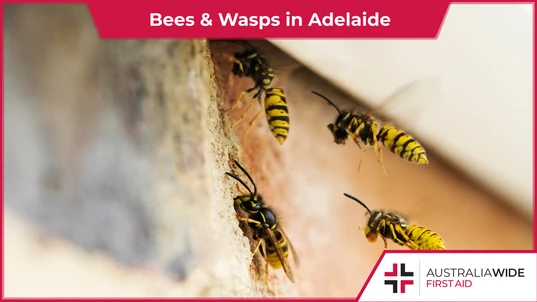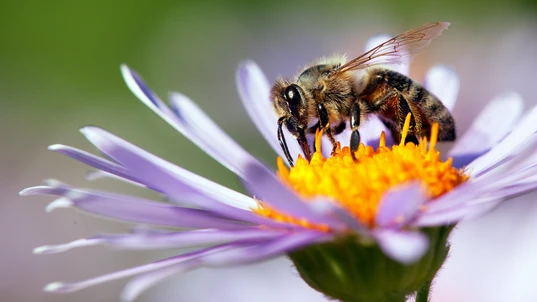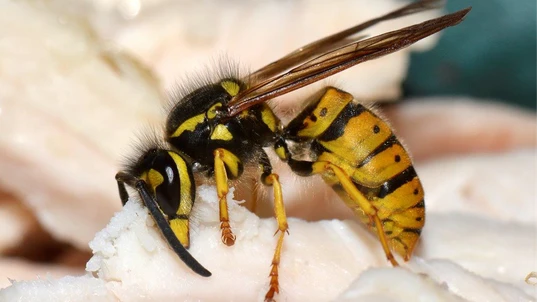All About Bees & Wasps in Adelaide

Bites and Stings

There are a variety of bees & wasps in Adelaide, all of which are particularly active during the warmer summer months. When bees and wasps infest homes, they can become territorial and attack in swarms.
Adelaide is brimming with a variety of native and introduced bee and wasp species - from bushlands to backyards to the walls or roof of your home. They are particularly active during the warmer summer months, working longer daylight hours to prepare for winter or settle into their new hives. It’s important to recognise the early signs of a bee and wasp infestation in your home. These insects become very territorial, aggressive and attack in swarms when they feel threatened. While bee and wasp stings are relatively harmless, they account for more than twice the number of hospital admissions than snake bites and cause almost the same number of deaths. Read on to find out more about bee and wasp infestations, when to call a pest control company, and how to treat a bee and wasp sting. We also cover bee and wasp stings in our following first aid courses: We run these courses in Adelaide and in an additional four locations across South Australia.
The Western honey bee, otherwise known as the European honey bee, was first introduced to Australia by early colonists in 1822. Bees are vital to human existence, as they carry pollen between plants, which fertilises them and allows them to reproduce.
Western honey bee
The Western honey bee is a common brown insect with a hairy body and an abdomen with dull yellow stripes. Usually about the size of a thumbnail, these bees were introduced to Australia for their honey by the early European settlers. The Western honey bee is highly social. Each hive contains roughly 5,000 to 40,000 bees and are run by a single queen. While the queen lays eggs and manages the hive through her pheromones, the rest of the female worker bees build and maintain the hive or collect nectar and pollen to feed the bee larvae. Western honey bees play an important role in pollinating flowers and crops. Unlike native Australian bees, the Western honey bee has a barbed stinger that will rip out the bee’s abdomen when released. This means the bee will die soon after releasing its stinger. As the stinger lodges into flesh, the poison gland continues to pump out toxins, so it’s important to remove the stinger as soon as possible. If an allergic reaction occurs from a sting, seek immediate medical attention. These bees are known to build nests inside house walls. If you notice an uptake in bee activity near your home for longer than 24 hours, or honey dripping from wall and roof cavities, do not approach it, but rather call a professional bee and wasp controller in Adelaide. Western honey bees can become very aggressively when their hive is under any perceived threat and will attack and sting in swarms.
The European wasp is native to areas in the northern hemisphere, including the United Kingdom, northern Europe, and northern Africa. Since their introduction to Australasia in 1945, they have wreaked sufficient havoc to become a declared pest.
European wasp
The European wasp is another introduced species in Australia that can give a nasty sting. Identified by its tendency to fly with its legs raised close to its body, the European wasp has long black antennae, a stout body, a yellow-and-black banded abdomen, and a double set of clear wings (with the first pair being larger than the second). European Wasps build nests underground, inside logs or trees, walls and ceilings. Their entrances are tiny holes, making it difficult to know how large a nest can be. A single wasp nest can host between 3,000 and 10,000 workers (the size of a soccer ball or bigger). These nests typically reach full size during the months of March and April. European wasps are considered a threat as they tend to establish their nests in areas occupied by humans. They chew cavities in the timber of both outdoor and indoor structures, and are especially attracted to meaty and sugary foods. Examples include exposed meat on the barbecue grill or on picnic plates, compostable garbage, fruit ripening on fruit trees, or pet food. European wasps are quite aggressive when disturbed, and unlike bees, wasps can sting a person several times without dying. If you notice a wasp coming and going from a small hole around your home, call a bee and wasp removal specialist to check it out. You can also contribute to research around the effects of European wasps on native species by reporting them.How to prevent bee and wasp infestations
Follow some simple tips to prevent bees and wasps from moving into your home:- Store food in a closed cupboard, an airtight container or in the fridge.
- Keep your doors and windows closed, or installs screens.
- Keep your yard maintained: clear rubbish, natural litter from trees or plants, mow your lawn regularly, ensure yard is draining properly - no water pooling.
- Seal any tiny cracks in your house walls or floors.
First aid for bee and wasp stings
Check out the following articles in our Resource Library to learn how to treat bee and wasp stings, respectively:Final thoughts
Adelaide can be subject to both bee and wasp infestations, particularly in the early summer months. It’s important to be able to recognise potential bee and wasp infestations. That way, you can contact an Adelaide bee and wasp controller to remove these pests before they establish a hive near you. Because bee and wasps attack when under threat, do not attempt to deal with these insects yourself. Bee and wasp stings cause the most hospitalisations from Australia’s long list of venomous insects and animals. To learn more about treating bee and wasp stings, attend one of our first aid courses in Adelaide or another location near you.
Originally published at
https://www.australiawidefirstaid.com.au/resources/bees-and-wasps-in-adelaide
as part of the Australia Wide First Aid Articles Library









